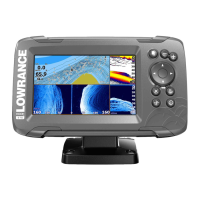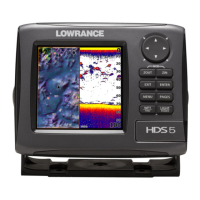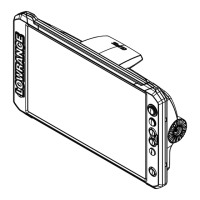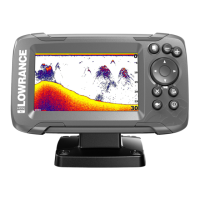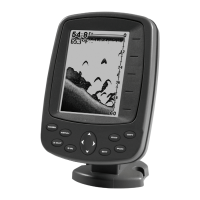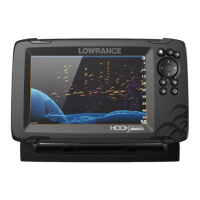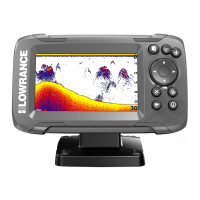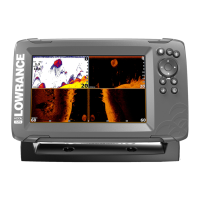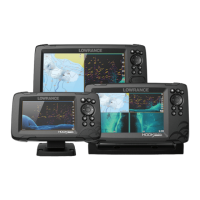Do you have a question about the Lowrance M68C IceMachine and is the answer not in the manual?
Details the hardware and software capabilities and specifications of the M68 unit.
Explains the fundamental principles of sonar technology for fish finding.
Explains the fundamental principles of GPS technology for navigation.
Explains the formatting and conventions used in the manual for clarity.
Provides instructions and guidelines for installing the sonar transducer on a boat.
Offers guidance on choosing the optimal location for transducer mounting.
Details the procedures for mounting the main sonar unit via dash or bracket.
Explains how to set up and use the sonar unit for portable operation.
Introduces the unit's keyboard layout and the function of each key.
Outlines the structure and access methods for the Main and Sonar menus.
Offers a concise, step-by-step guide to basic sonar operations for quick reference.
Explains how to perform basic sonar functions and interpret the display.
Describes the ASP feature for noise rejection and improving display clarity.
Details how to set and manage various sonar alarms like depth and fish alarms.
Explains the ColorLine feature for distinguishing strong and weak echoes.
Covers the automatic depth ranging feature to keep the bottom visible.
Introduces the specific features and operation for ice fishing.
Guides on how to activate and use the IceMachine mode.
Explains how to adjust sensitivity for optimal ice fishing sonar performance.
Helps users understand how to interpret sonar signals on the flasher screen.
Provides steps to diagnose and resolve issues where the unit does not power on.
Offers solutions for common problems like unit freezing or erratic operation.
Addresses issues with bottom echo, erratic readings, or missing fish signals.
Describes the function of each key on the unit's keyboard.
Explains how to access and navigate the unit's main menu system.
Details how to switch between different GPS pages like Map, Position, and Navigation.
Explains how to use the Navigation Page for directional guidance.
Covers creating, managing, and navigating to icons on the map.
Details how to create, save, edit, and navigate routes using waypoints.
Explains how to create, save, edit, display, and navigate trails.
Introduces various utility functions like alarm clock and calculators.
Explains how to select different coordinate systems for displaying positions.
Details how to use the Map Fix feature for referencing positions on maps.
Guides on customizing data boxes displayed on map and navigation pages.
Explains how to find map features using the cursor on the Map Page.
Covers searching for map places by name or proximity.
Details how to search for specific streets and intersections.
Explains how to find stored waypoints by name or nearest location.
Lists the various datums supported by the unit for map accuracy.
Details the hardware and software capabilities and specifications of the M68 unit.
Explains the fundamental principles of sonar technology for fish finding.
Explains the fundamental principles of GPS technology for navigation.
Explains the formatting and conventions used in the manual for clarity.
Provides instructions and guidelines for installing the sonar transducer on a boat.
Offers guidance on choosing the optimal location for transducer mounting.
Details the procedures for mounting the main sonar unit via dash or bracket.
Explains how to set up and use the sonar unit for portable operation.
Introduces the unit's keyboard layout and the function of each key.
Outlines the structure and access methods for the Main and Sonar menus.
Offers a concise, step-by-step guide to basic sonar operations for quick reference.
Explains how to perform basic sonar functions and interpret the display.
Describes the ASP feature for noise rejection and improving display clarity.
Details how to set and manage various sonar alarms like depth and fish alarms.
Explains the ColorLine feature for distinguishing strong and weak echoes.
Covers the automatic depth ranging feature to keep the bottom visible.
Introduces the specific features and operation for ice fishing.
Guides on how to activate and use the IceMachine mode.
Explains how to adjust sensitivity for optimal ice fishing sonar performance.
Helps users understand how to interpret sonar signals on the flasher screen.
Provides steps to diagnose and resolve issues where the unit does not power on.
Offers solutions for common problems like unit freezing or erratic operation.
Addresses issues with bottom echo, erratic readings, or missing fish signals.
Describes the function of each key on the unit's keyboard.
Explains how to access and navigate the unit's main menu system.
Details how to switch between different GPS pages like Map, Position, and Navigation.
Explains how to use the Navigation Page for directional guidance.
Covers creating, managing, and navigating to icons on the map.
Details how to create, save, edit, and navigate routes using waypoints.
Explains how to create, save, edit, display, and navigate trails.
Introduces various utility functions like alarm clock and calculators.
Explains how to select different coordinate systems for displaying positions.
Details how to use the Map Fix feature for referencing positions on maps.
Guides on customizing data boxes displayed on map and navigation pages.
Explains how to find map features using the cursor on the Map Page.
Covers searching for map places by name or proximity.
Details how to search for specific streets and intersections.
Explains how to find stored waypoints by name or nearest location.
Lists the various datums supported by the unit for map accuracy.
| Display Size | 3.5 inches |
|---|---|
| Display Type | Color LCD |
| GPS | Yes |
| Sonar Frequency | 200 kHz |
| Power Output | 1500 watts peak-to-peak |
| Operating Temperature | -20°C to 55°C (-4°F to 131°F) |
